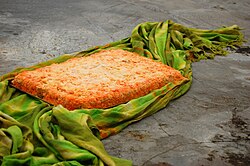 A block of red oncom | |
| Course | Main course |
|---|---|
| Place of origin | Indonesia |
| Region or state | West Java |
| Associated cuisine | Indonesia |
Oncom (IPA: ɔnˈtʃɔm) is one of the traditional staple foods of the Sundanese cuisine of Indonesia. There are two kinds of oncom: red oncom and black oncom. Oncom is closely related to tempeh; both are foods fermented using mold.[1]
Usually, oncom is made from the by-products from the production of other foods: soy pulp remains from making tofu, peanut press cake remains after the oil has been pressed out, cassava tailings when extracting the starch (pati singkong), coconut press cake remaining after the oil has been pressed out or when coconut milk has been produced. Since oncom production uses by-products to make food, it increases the economic efficiency of food production.
Black oncom is made by using Rhizopus oligosporus while red oncom is made by using Neurospora intermedia var. oncomensis.[2] It is the only traditional human food produced from Neurospora.
Red oncom has been found to reduce the cholesterol levels of rats.[3]
- ^ Sastraatmadja, D. D.; et al. (2002). "Production of High-Quality Oncom, a Traditional Indonesian Fermented Food, by the Inoculation with Selected Mold Strains in the Form of Pure Culture and Solid Inoculum". Journal of the Graduate School of Agriculture, Hokkaido University. 70: 111–127. CiteSeerX 10.1.1.866.6352. hdl:2115/13163.
- ^ Ho, C.C. (1986). "Identity and characteristics of Neurospora intermedia responsible for oncom fermentation in Indonesia". Food Microbiology. 3 (2): 115–132. doi:10.1016/S0740-0020(86)80035-1.
- ^ "Plasma cholesterol reduction by defatted soy ontjom (fermented with Neurospora intermedia) in rats fed a cholesterol-free diet". usda.gov. Archived from the original on 19 July 2009. Retrieved 25 March 2019.